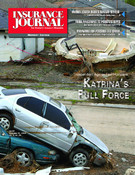Industry representatives generally support state regulators’ efforts to craft a comprehensive plan for natural catastrophes but take issue with elements of the draft proposal that was aired during the recent meeting of the National Association of Insurance Commissioners.
The current NAIC draft goes too far, too fast and in the wrong direction. It also preempts private insurer and consumer initiatives and replaces it with a government program, counseled American Insurance Association Vice President Dave Snyder.
“Let’s recognize that all the systems in the private market for responding to catastrophe are not necessarily broken,” Snyder said.
San Francisco summit
California, Florida, Illinois and New York regulators unveiled the national proposal at a San Francisco Catastrophe Summit in November. The commissioners said their aims are to create a plan to protect renters and homeowners by ensuring the affordability and availability of insurance against the financial consequences of catastrophic events. The regulators also want to spread the risk broadly among individual insureds, insurers, reinsurers, states and the federal government in a public-private partnership, as well as reward mitigation of hazards. However, the NAIC draft raised questions for some in the industry.
The AIA, along with GeoVera Holdings Inc., Liberty Mutual Insurance Companies, the Reinsurance Association of America and St. Paul Travelers, wrote the NAIC to urge states to “take into account the private sector’s ability to manage natural catastrophic risk before embracing extraordinarily complex governmental solutions that could adversely affect state or federal taxpayers and create unintended consequences in insurance markets leaving consumers at greater risk.”
“…Natural catastrophes are simply too varied to lend themselves to a uniform ‘Cat Fund’ solution for all jurisdictions, insurers and policyholders,” their letter read.
In addition to resisting the federal government’s involvement in a solution, insurers also identified the plan’s proposed all-perils policy as a sticking point. Insurers say such a policy could create cross-subsidy problems by having homeowners in low risk, non-coastal areas subsidizing those in high-risk areas, as well as creating cross-subsidy problems for all lines of insurance.
According to the NAIC draft, the proposed all-perils policy would indemnify homeowners in the event of damage to their home, regardless of the cause (minus the deductible). The policy would be mandated and contain no exclusions except for acts of war. In addition, the policy would contain the usual $500 or $1,000 deductible for non-catastrophic losses, but require a separate deductible for catastrophic losses based on a percentage of insured value that could range from 2 to 10 percent. A policyholder could opt for an endorsement to buy the catastrophic deductible down to the non-catastrophic deductible.
Industry representatives questioned whether the mandated all-perils policy could be based on actuarially sound principles. “The policy is too broad and comprehensive and our worry is that a lot of consumers who really need it won’t be able to afford it,” AIA’s Snyder said.
State Farm’s Steve McManus agreed, suggesting that rate regulation and underwriting tools could affect the policy’s price. “In order to attract capital to the market place, regulators should permit insurers to freely use underwriting and rating tools to more accurately price their product. Companies will have more confidence in the marketplace, knowing their products are accurately priced,” McManus said. “Cost-based pricing of any policy is critically important.”
Others supported the regulators in their overall effort and urged the NAIC to act quickly. Allstate Insurance counsel Ed Collins pushed to get “a bill to the president early next year, before the next Hurricane season.”
Tax reserve issue
The NAIC draft recommends that insurers be allowed to set aside some portion of premiums as reserves for future events. The NAIC has suggested amending the tax code so that reserves could be tax deferred. Rep. Mark Foley (Fla.) has sponsored H.R. 2668, which would allow insurers to voluntarily create reserves on a tax-deferred basis up to a cap. The NAIC hopes the Foley bill might work as a vehicle to get the issue to the floor where details can be discussed.
The Property Casualty Insurers Association of America said it supports provisions that would allow insurers to establish voluntary, tax-deferred catastrophe reserves. However, PCI cautioned that economic and political issues further complicate a solution.
Historically there has been little support in less disaster-prone states for federal involvement in a federal disaster insurance program, according to Ernie Csiszar, president and chief executive officer of PCI. In addition to a tax deferment, Csiszar offered that mitigation and prevention also should be components of the NAIC catastrophe proposal.
Topics Catastrophe Carriers
Was this article valuable?
Here are more articles you may enjoy.


 New York State Police Report 37-Vehicle Pileup on I-81 Near Syracuse
New York State Police Report 37-Vehicle Pileup on I-81 Near Syracuse  Expense Ratio Analysis: AI, Remote Work Drive Better P/C Insurer Results
Expense Ratio Analysis: AI, Remote Work Drive Better P/C Insurer Results  Grandson Not Covered Under Grandma’s Home Insurance
Grandson Not Covered Under Grandma’s Home Insurance  LA Fire Survivors Got a Rude Surprise That Could Hit More Americans
LA Fire Survivors Got a Rude Surprise That Could Hit More Americans 


